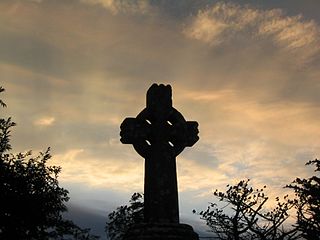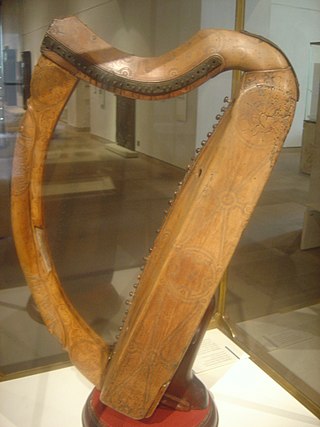Plainsong or plainchant is a body of chants used in the liturgies of the Western Church. When referring to the term plainsong, it is those sacred pieces that are composed in Latin text. Plainsong was the exclusive form of Christian church music until the ninth century, and the introduction of polyphony.

Celtic Christianity is a form of Christianity that was common, or held to be common, across the Celtic-speaking world during the Early Middle Ages. Some writers have described a distinct Celtic Church uniting the Celtic peoples and distinguishing them from adherents of the Roman Church, while others classify Celtic Christianity as a set of distinctive practices occurring in those areas. Varying scholars reject the former notion, but note that there were certain traditions and practices present in both the Irish and British churches that were not seen in the wider Christian world.

Gregorian chant is the central tradition of Western plainchant, a form of monophonic, unaccompanied sacred song in Latin of the Roman Catholic Church. Gregorian chant developed mainly in western and central Europe during the 9th and 10th centuries, with later additions and redactions. Although popular legend credits Pope Gregory I with inventing Gregorian chant, scholars believe that it arose from a later Carolingian synthesis of the Old Roman chant and Gallican chant.

The Mass is a form of sacred musical composition that sets the invariable portions of the Christian Eucharistic liturgy, known as the Mass.

A neume is the basic element of Western and Eastern systems of musical notation prior to the invention of five-line staff notation.

The gradual is a certain chant or hymn in liturgical Christian worship. It is practiced in the Catholic Mass, Lutheran Divine Service, Anglican service and other traditions. It gets its name from the Latin gradus because it was once chanted on the step of the ambo or altar. It is customarily placed after a reading of scripture.

The Introit is part of the opening of the liturgical celebration of the Eucharist for many Christian denominations. In its most complete version, it consists of an antiphon, psalm verse and Gloria Patri, which are spoken or sung at the beginning of the celebration. It is part of the proper of the liturgy: that is, the part that changes over the liturgical year.
The Gallican Rite is a historical form of Christian liturgy and other ritual practices in Western Christianity. It is not a single liturgical rite but rather several Latin liturgical rites that developed within the Latin Church, which comprised the majority use of most of Western Christianity for the greater part of the 1st millennium AD. The rites first developed in the early centuries as the Syriac-Greek rites of Jerusalem and Antioch and were first translated into Latin in various parts of the Western Roman Empire Praetorian prefecture of Gaul. By the 5th century, it was well established in the Roman civil diocese of Gaul, which had a few early centers of Christianity in the south. Ireland is also known to have had a form of this Gallican Liturgy mixed with Celtic customs.

An antiphonary or antiphonal is one of the liturgical books intended for use in choro, and originally characterized, as its name implies, by the assignment to it principally of the antiphons used in various parts of the Latin liturgical rites.

Latin liturgical rites, or Western liturgical rites, is a large family of liturgical rites and uses of public worship employed by the Latin Church, the largest particular church sui iuris of the Catholic Church, that originated in Europe where the Latin language once dominated. Its language is now known as Ecclesiastical Latin. The most used rite is the Roman Rite.
Gallican chant refers to the liturgical plainchant repertory of the Gallican rite of the Roman Catholic Church in Gaul, prior to the introduction and development of elements of the Roman rite from which Gregorian chant evolved. Although the music was largely lost, traces are believed to remain in the Gregorian corpus.
Ambrosian chant is the liturgical plainchant repertory of the Ambrosian rite of the Roman Catholic Church, related to but distinct from Gregorian chant. It is primarily associated with the Archdiocese of Milan, and named after St. Ambrose much as Gregorian chant is named after Gregory the Great. It is the only surviving plainchant tradition besides the Gregorian to maintain the official sanction of the Roman Catholic Church.
Mozarabic chant is the liturgical plainchant repertory of the Visigothic/Mozarabic rite of the Catholic Church, related to the Gregorian chant. It is primarily associated with Hispania under Visigothic rule and later with the Mozarabs and was replaced by the chant of the Roman rite following the Christian Reconquest of the Iberian Peninsula. Although its original medieval form is largely lost, a few chants have survived with readable musical notation, and the chanted rite was later revived in altered form and continues to be used in a few isolated locations in Spain, primarily in Toledo.

Beneventan chant is a liturgical plainchant repertory of the Roman Catholic Church, used primarily in the orbit of the southern Italian ecclesiastical centers of Benevento and Monte Cassino distinct from Gregorian chant and related to Ambrosian chant. It was officially supplanted by the Gregorian chant of the Roman rite in the 11th century, although a few Beneventan chants of local interest remained in use.
Old Roman chant is the liturgical plainchant repertory of the Roman rite of the early Christian Church. It was formerly performed in Rome, and, although it is closely related to Gregorian chant, the two are distinct. Unlike other chant traditions, Old Roman chant and Gregorian chant share essentially the same liturgy and the same texts. Many of their melodies are also closely related. Although primarily associated with the churches of Rome, the Old Roman chant was also performed in parts of central Italy, and it was possibly performed much more widely. Gregorian Chant gradually but completely supplanted Old Roman Chant between the 11th century and the 13th century AD.

The modern state of Italy did not come into being until 1861, though the roots of music on the Italian Peninsula can be traced back to the music of ancient Rome. However, the underpinnings of much modern Italian music come from the Middle Ages.

Music in Medieval Scotland includes all forms of musical production in what is now Scotland between the fifth century and the adoption of the Renaissance in the early sixteenth century. The sources for Scottish Medieval music are extremely limited. There are no major musical manuscripts for Scotland from before the twelfth century. There are occasional indications that there was a flourishing musical culture. Instruments included the cithara, tympanum, and chorus. Visual representations and written sources demonstrate the existence of harps in the Early Middle Ages and bagpipes and pipe organs in the Late Middle Ages. As in Ireland, there were probably filidh in Scotland, who acted as poets, musicians and historians. After this "de-gallicisation" of the Scottish court in the twelfth century, a less highly regarded order of bards took over the functions of the filidh and they would continue to act in a similar role in the Scottish Highlands and Islands into the eighteenth century.
The Schola Cantorum was the trained papal choir during the Middle Ages, specializing in the performance of plainchant for the purpose of rendering the music in church. In the fourth century, Pope Sylvester I was said to have inaugurated the first Schola Cantorum, but it was Pope Gregory I who established the school on a firm basis and endowed it. The choir ranged anywhere from twenty to thirty boys or men. Only the most skilled in singing were selected to participate in the Schola Cantorum.

Church music in Scotland includes all musical composition and performance of music in the context of Christian worship in Scotland, from the beginnings of Christianisation in the fifth century, to the present day. The sources for Scottish Medieval music are extremely limited due to factors including a turbulent political history, the destructive practices of the Scottish Reformation, the climate and the relatively late arrival of music printing. In the early Middle Ages, ecclesiastical music was dominated by monophonic plainchant, which led to the development of a distinct form of liturgical Celtic chant. It was superseded from the eleventh century by more complex Gregorian chant. In the High Middle Ages, the need for large numbers of singing priests to fulfill the obligations of church services led to the foundation of a system of song schools, to train boys as choristers and priests. From the thirteenth century, Scottish church music was increasingly influenced by continental developments. Monophony was replaced from the fourteenth century by the Ars Nova consisting of complex polyphony. Survivals of works from the first half of the sixteenth century indicate the quality and scope of music that was undertaken at the end of the Medieval period. The outstanding Scottish composer of the first half of the sixteenth century was Robert Carver, who produced complex polyphonic music.

Music in Medieval England, from the end of Roman rule in the fifth century until the Reformation in the sixteenth century, was a diverse and rich culture, including sacred and secular music and ranging from the popular to the elite.













